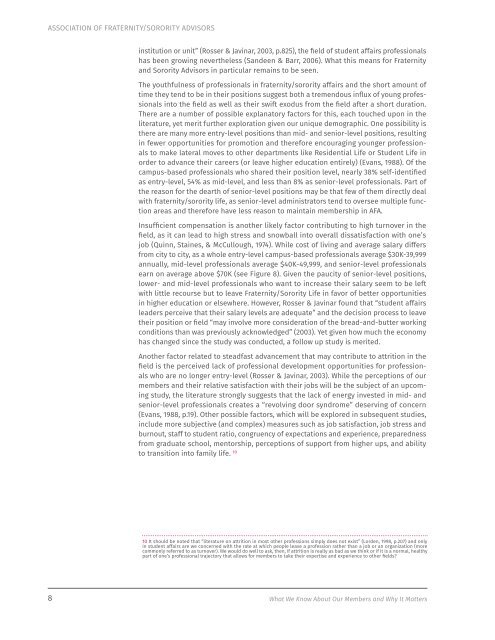The Association of Fraternity/Sorority Advisors Membership
21wXrUv
21wXrUv
You also want an ePaper? Increase the reach of your titles
YUMPU automatically turns print PDFs into web optimized ePapers that Google loves.
ASSOCIATION OF FRATERNITY/SORORITY ADVISORS<br />
institution or unit” (Rosser & Javinar, 2003, p.825), the field <strong>of</strong> student affairs pr<strong>of</strong>essionals<br />
has been growing nevertheless (Sandeen & Barr, 2006). What this means for <strong>Fraternity</strong><br />
and <strong>Sorority</strong> <strong>Advisors</strong> in particular remains to be seen.<br />
<strong>The</strong> youthfulness <strong>of</strong> pr<strong>of</strong>essionals in fraternity/sorority affairs and the short amount <strong>of</strong><br />
time they tend to be in their positions suggest both a tremendous influx <strong>of</strong> young pr<strong>of</strong>essionals<br />
into the field as well as their swift exodus from the field after a short duration.<br />
<strong>The</strong>re are a number <strong>of</strong> possible explanatory factors for this, each touched upon in the<br />
literature, yet merit further exploration given our unique demographic. One possibility is<br />
there are many more entry-level positions than mid- and senior-level positions, resulting<br />
in fewer opportunities for promotion and therefore encouraging younger pr<strong>of</strong>essionals<br />
to make lateral moves to other departments like Residential Life or Student Life in<br />
order to advance their careers (or leave higher education entirely) (Evans, 1988). Of the<br />
campus-based pr<strong>of</strong>essionals who shared their position level, nearly 38% self-identified<br />
as entry-level, 54% as mid-level, and less than 8% as senior-level pr<strong>of</strong>essionals. Part <strong>of</strong><br />
the reason for the dearth <strong>of</strong> senior-level positions may be that few <strong>of</strong> them directly deal<br />
with fraternity/sorority life, as senior-level administrators tend to oversee multiple function<br />
areas and therefore have less reason to maintain membership in AFA.<br />
Insufficient compensation is another likely factor contributing to high turnover in the<br />
field, as it can lead to high stress and snowball into overall dissatisfaction with one’s<br />
job (Quinn, Staines, & McCullough, 1974). While cost <strong>of</strong> living and average salary differs<br />
from city to city, as a whole entry-level campus-based pr<strong>of</strong>essionals average $30K-39,999<br />
annually, mid-level pr<strong>of</strong>essionals average $40K-49,999, and senior-level pr<strong>of</strong>essionals<br />
earn on average above $70K (see Figure 8). Given the paucity <strong>of</strong> senior-level positions,<br />
lower- and mid-level pr<strong>of</strong>essionals who want to increase their salary seem to be left<br />
with little recourse but to leave <strong>Fraternity</strong>/<strong>Sorority</strong> Life in favor <strong>of</strong> better opportunities<br />
in higher education or elsewhere. However, Rosser & Javinar found that “student affairs<br />
leaders perceive that their salary levels are adequate” and the decision process to leave<br />
their position or field “may involve more consideration <strong>of</strong> the bread-and-butter working<br />
conditions than was previously acknowledged” (2003). Yet given how much the economy<br />
has changed since the study was conducted, a follow up study is merited.<br />
Another factor related to steadfast advancement that may contribute to attrition in the<br />
field is the perceived lack <strong>of</strong> pr<strong>of</strong>essional development opportunities for pr<strong>of</strong>essionals<br />
who are no longer entry-level (Rosser & Javinar, 2003). While the perceptions <strong>of</strong> our<br />
members and their relative satisfaction with their jobs will be the subject <strong>of</strong> an upcoming<br />
study, the literature strongly suggests that the lack <strong>of</strong> energy invested in mid- and<br />
senior-level pr<strong>of</strong>essionals creates a “revolving door syndrome” deserving <strong>of</strong> concern<br />
(Evans, 1988, p.19). Other possible factors, which will be explored in subsequent studies,<br />
include more subjective (and complex) measures such as job satisfaction, job stress and<br />
burnout, staff to student ratio, congruency <strong>of</strong> expectations and experience, preparedness<br />
from graduate school, mentorship, perceptions <strong>of</strong> support from higher ups, and ability<br />
to transition into family life. 10<br />
10 It should be noted that “literature on attrition in most other pr<strong>of</strong>essions simply does not exist” (Lorden, 1998, p.207) and only<br />
in student affairs are we concerned with the rate at which people leave a pr<strong>of</strong>ession rather than a job or an organization (more<br />
commonly referred to as turnover). We would do well to ask, then, if attrition is really as bad as we think or if it is a normal, healthy<br />
part <strong>of</strong> one’s pr<strong>of</strong>essional trajectory that allows for members to take their expertise and experience to other fields?<br />
8 What We Know About Our Members and Why It Matters


